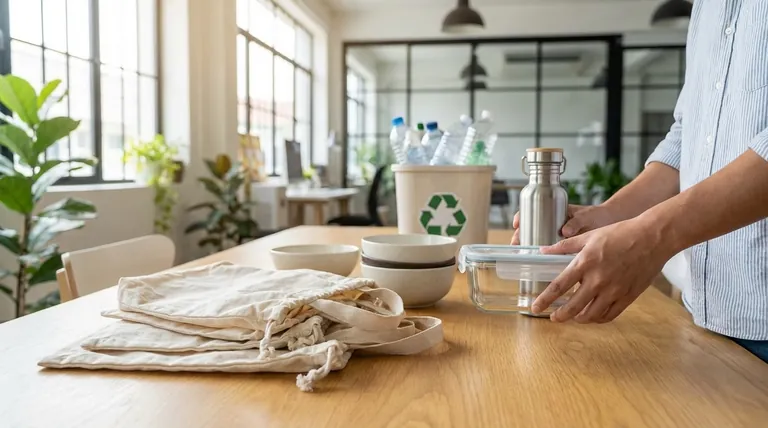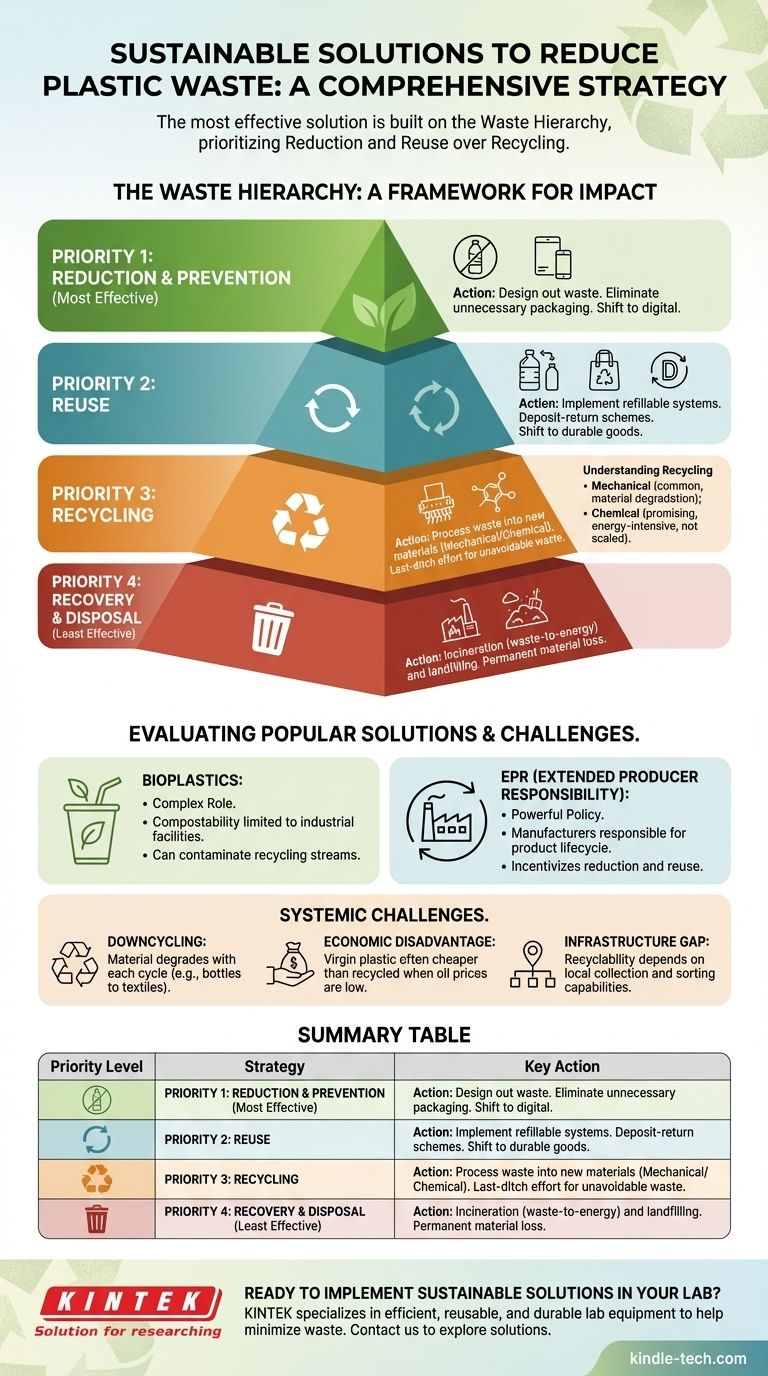Embora nenhuma tecnologia isolada ofereça uma solução mágica, a solução mais eficaz e sustentável para reduzir o desperdício de plástico é uma estratégia abrangente construída sobre a Hierarquia de Resíduos. Esta estrutura prioriza as ações em ordem de impacto ambiental, dando a maior ênfase à Redução e à Reutilização muito antes de considerar a reciclagem. Esta abordagem ataca o problema na fonte, em vez de apenas gerenciar os sintomas.
O erro crítico é focar na reciclagem como a solução principal. A verdadeira sustentabilidade é alcançada ao repensar fundamentalmente o design, o consumo e as políticas para eliminar a necessidade de plásticos de uso único desde o início.

A Fundação: Compreendendo a Hierarquia de Resíduos
A Hierarquia de Resíduos é uma estrutura universalmente aceite que orienta a gestão sustentável de resíduos. Ela classifica as opções de gestão de resíduos da mais à menos preferível, forçando uma mudança de foco de problemas a jusante (como a reciclagem) para soluções a montante (como a prevenção).
Prioridade 1: Redução e Prevenção
Este é o passo com maior impacto. O plástico mais sustentável é aquele que nunca é criado.
A redução envolve projetar sistemas e produtos que exijam menos material ou nenhum plástico. Isso inclui eliminar embalagens desnecessárias, "aliviar o peso" de produtos essenciais e mudar para alternativas digitais.
Prioridade 2: Reutilização
Se o plástico não puder ser eliminado, a próxima melhor opção é mantê-lo em uso pelo maior tempo possível em sua forma original.
Sistemas de reutilização, como recipientes recarregáveis para bebidas e produtos de limpeza ou esquemas de depósito e devolução, preservam o valor do material e reduzem significativamente a energia e os recursos necessários para criar novos itens. Representa uma mudança de uma mentalidade descartável para uma durável.
Prioridade 3: Reciclagem
A reciclagem é o processo de recuperação de sucata ou resíduos plásticos e seu reprocessamento em novos produtos. É uma parte crucial da solução, mas é a terceira melhor opção por uma razão.
Embora desvie material de aterros sanitários, o processo tem limitações significativas, incluindo consumo de energia, degradação do material e problemas de contaminação. Deve ser visto como um último recurso para itens que não podem ser eliminados ou reutilizados.
O Último Recurso: Recuperação e Eliminação
Este nível inclui processos como incineração com recuperação de energia e, o menos desejável, aterro sanitário. Essas opções são reservadas para resíduos que não podem ser prevenidos, reutilizados ou reciclados e resultam na perda permanente de recursos materiais.
Avaliando "Soluções" Populares Através Desta Lente
Muitas soluções propostas ganham atenção da mídia, mas sua verdadeira sustentabilidade pode ser avaliada usando a Hierarquia de Resíduos.
O Papel dos Bioplásticos
Os bioplásticos são frequentemente apresentados como uma solução simples, mas seu papel é complexo. Alguns são projetados para serem compostáveis, mas apenas em instalações industriais, não em uma lixeira doméstica ou no ambiente aberto.
Além disso, sua produção pode ter sua própria pegada ambiental relacionada ao uso da terra e da água. Se entrarem em fluxos de reciclagem de plástico convencionais, atuam como contaminantes, podendo estragar lotes inteiros de material reciclável.
O Poder da Responsabilidade Estendida do Produtor (REP)
A REP é uma abordagem política que torna os fabricantes responsáveis por todo o ciclo de vida de seus produtos, incluindo sua coleta e eliminação final.
Este é um alavanca poderosa para a Redução e a Reutilização. Quando as empresas arcam com o custo financeiro de seus resíduos de embalagem, elas são diretamente incentivadas a projetar produtos que sejam mais leves, mais fáceis de reutilizar e reciclados de forma mais eficiente.
Reciclagem Química vs. Mecânica
A reciclagem mecânica, o tipo mais comum, envolve triturar, lavar, derreter e reformar o plástico. A reciclagem química (ou "reciclagem avançada") usa vários processos para decompor os plásticos em seus blocos de construção moleculares originais, que podem então ser usados para criar plásticos novos, com qualidade virgem.
Embora a reciclagem química ofereça promessas para lidar com plásticos mistos de difícil reciclagem, atualmente ela consome muita energia, muitas vezes tem baixos rendimentos e ainda não foi comprovada em escala grande e economicamente viável.
Compreendendo as Compensações e os Desafios Sistêmicos
Alcançar uma economia circular para plásticos requer o reconhecimento dos obstáculos significativos que existem dentro do sistema atual.
O Mito da Reciclabilidade Infinita
A maioria dos plásticos comuns não pode ser reciclada indefinidamente. O processo de derreter e reformar o plástico degrada as cadeias de polímeros, um fenômeno conhecido como downcycling (subciclagem).
Após alguns ciclos, o material perde sua integridade estrutural e deve ser usado para produtos de qualidade inferior (por exemplo, garrafas plásticas viram têxteis ou madeira) até ser eventualmente descartado em aterro sanitário ou incinerado.
A Desvantagem Econômica
O plástico reciclado deve competir com o plástico virgem, que é produzido diretamente a partir de combustíveis fósseis. Quando os preços do petróleo estão baixos, o plástico virgem é frequentemente mais barato e de maior qualidade do que seu equivalente reciclado, criando um incentivo econômico fraco para os fabricantes usarem conteúdo reciclado.
A Lacuna de Infraestrutura
A reciclabilidade de um produto é inútil sem a infraestrutura local para coletá-lo, classificá-lo e processá-lo. A disponibilidade e a capacidade das instalações de reciclagem variam drasticamente entre municípios e países, levando a uma confusão generalizada entre os consumidores e baixas taxas reais de reciclagem.
Fazendo a Escolha Certa para o Seu Objetivo
Para contribuir efetivamente para a solução, suas ações devem estar alinhadas com a Hierarquia de Resíduos.
- Se você é um designer de produto ou líder de negócios: Seu foco principal deve ser eliminar o desperdício desde o início, explorando materiais sem plástico e investindo em sistemas robustos de reutilização e recarga.
- Se você é um legislador: Priorize legislação como a Responsabilidade Estendida do Produtor (REP) e forneça financiamento para infraestrutura de reutilização, o que cria incentivos a montante para reduzir o desperdício.
- Se você é um consumidor individual: Seu maior poder reside em reduzir o consumo de itens de uso único e escolher ativamente alternativas reutilizáveis, fazendo da reciclagem sua última opção, não a primeira.
Um futuro sustentável para os plásticos é alcançado não gerenciando melhor os resíduos, mas criando um sistema econômico e social que não os produza em primeiro lugar.
Tabela de Resumo:
| Nível de Prioridade | Estratégia | Ação Chave |
|---|---|---|
| 1 (Mais Eficaz) | Redução e Prevenção | Eliminar o desperdício no design, eliminar embalagens desnecessárias |
| 2 | Reutilização | Implementar sistemas de recarga, esquemas de depósito e devolução |
| 3 | Reciclagem | Processar resíduos em novos materiais (mecânica/química) |
| 4 (Menos Eficaz) | Recuperação e Eliminação | Incineração, aterro sanitário como último recurso |
Pronto para implementar soluções sustentáveis no seu laboratório? A KINTEK é especializada em equipamentos e consumíveis de laboratório, ajudando os laboratórios a minimizar o desperdício através de produtos eficientes, reutilizáveis e duráveis. Deixe-nos apoiar seus objetivos de sustentabilidade — entre em contato com nossos especialistas hoje para explorar como nossas soluções podem reduzir seu impacto ambiental, mantendo alto desempenho.
Guia Visual

Produtos relacionados
- Película de Embalagem Flexível de Alumínio-Plástico para Embalagem de Bateria de Lítio
- Fabricante Personalizado de Peças de PTFE Teflon Usinadas e Moldadas para Limpeza de Vidro Condutor ITO FTO de Laboratório Cesto de Flores
- Forno Rotativo Elétrico Pequeno Forno de Pirólise de Biomassa
- Fabricante Personalizado de Peças de PTFE Teflon para Cremalheiras de Limpeza
- Unidade de Destilação de Água Montada na Parede
As pessoas também perguntam
- Qual é a diferença entre filme de camada única e filme multicamadas? Um Guia para Seleção de Materiais
- Qual é o revestimento mais fino? Desbloqueando Propriedades Únicas na Escala Atômica
- Qual é a diferença entre filme monocamada e multicamada? Escolha a Embalagem Certa para o Seu Produto
- O que é a técnica de filme soprado? Um Guia para a Produção de Filmes Plásticos de Alta Resistência
- Como o lixo plástico difere de outros tipos de lixo? A Ameaça Oculta dos Microplásticos







